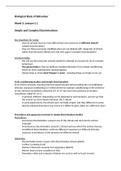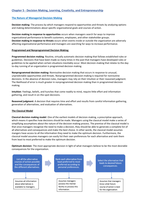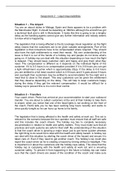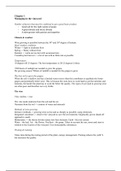PART 1: THE MEANING OF CULTURE
CHAPTER 1: THE UNDERTOW OF CULTURE
Steps in managing across cultures:
Recognize that culture matters. To do so we need to challenge 3 important myths or convergence:
• Myth #1: The world is getting smaller, cultural differences are
disappearing.
• Myth #2: Management is management’à Many managers argue that
management is management, consisting of a set of principles and
techniques that can be universally applied. All too often managers
assume that what works in one culture will work in another. An example
is that even doctor in different countries have different approaches to
medication.
• Myth #3: Global integration means standardizationà Cultural
differences will be less influential as companies are globalizing their
operations and becoming more standardized across countries and
regions. Therefore, the impact of cultural differences will diminish and
inefficiencies and conflicts associated with culture diversity will
disappear.
Forces for and against convergence:
The pace of technological and economic development of the BRIC countries has been quite
impressive and indeed bears some evidence of convergence. It seems that there are equal or greater
forces for fragmentation, one of them being culture. Ethnic conflict continues to flare around the
world; nationalism and global terrorism are on the rise; and there are many groups who resist
globalization and the associated lifestyles (materialism versus spiritualism) à convergence at a
superficial level may trigger resistance, revealing divergence at a deeper level.
Culture as a source of competitive advantage:
Each country has its unique institutional and cultural characteristics, which can provide sources of
competitive advantage at one point, only to become potential liabilities when the environment
changes.
, DEFINING CULTURE
Culture characteristics:
• An interrelated system of dimensions
• Sets of ways of perceiving, thinking, feeling, behaving and evaluating
• Provides a reference frame for action and decisions
• More or less shared at the group level
• Learned through socialization
More recent conceptualizations of culture highlight several tensions or dualities:
• Primacy of national culture
• Monolithic versus pluralistic: Monolithic is assuming that differences between cultural
groups are more important than differences within a group
• Stable versus dynamic. Finally, many scholars argue that culture changes very slowly
According to Kluckholn and Strodtbeck culture might be described as shared assumptions, values
and behaviors that distinguish one group from another and are passed on from one generation to
the next.
CULTURE CLASH OR SYNERGY?
• Differences in culture between merging organizations may have an adverse impact on
employee commitment, trust in management and development of a sense of shared identity.
• Differences in national as well as corporate culture can make integration even more
challenging.
• Provide a competitive advantage by providing access to unique and potentially valuable
capabilities embedded in a different culture, by helping the acquirer to develop richer
knowledge structures and by fostering learning and innovation.
However, they can also be a source of value creation, innovation and learning, but culture
differences cannot be ignored. Failure to pay attention to cultural differences can have grave
consequences. Many Chinese mergers ended up in a disaster, often due to the cross-cultural
differences. What may be valued in one culture, may be considered irrelevant in another culture.
According to Ghosn, cultural differences can be viewed as either a handicap or a powerful seed for
something new.
Companies (1) need to analyze the potential for cultural clashes that can undermine good
intentions, (2) need to recognize the symphony of cultural malaise and diagnose what is causing the
irritation, (3) to capture the potential benefits while limiting the potential misunderstanding,
managers must be prepared to articulate how they see their own culture and to recognize how
others may experience it.
The reason behind these failures is not only that behaviors, values and beliefs are different across
cultures, but also that their importance to those cultures should not be underestimated. What
, people in one culture value or perceive as sacred may be considered irrelevant in another culture,
or even disrespect.
RECOGNIZING CULTURE
Culture can have a very profound effect on perception, cognition and behavior without even bring
aware of it.
Cultural differences in cognition: how people perceive and organize the world-are profound and
have far-reaching implications for management.
Considered by Hofstede as a ‘collective programming of the mind’, culture can have a very profound
effect on perception, cognition and behavior without even being aware of it.
HOW WE SEE US, HOW THEY SEE US
We only begin to perceive our culture when we are out of it, confronted with another. Culture
serves as a lens through which we perceive the other. The Johari window provides a way of
discussing and ‘negotiating’ the different perspectives.
Figure 1.4 Opening the Johari window (Managing Across Cultures, p.17)
The Johari Window can be used to stimulate awareness, - first by using managers to describe their
culture as they see it (as we see us), then others see it (as they see us).
Cultural differences at work (how we see us, how they;
Discuss differences that are plain to see (obvious to both)
Begin to explore or shed some light on what others cannot see (‘my’ blind spot)












